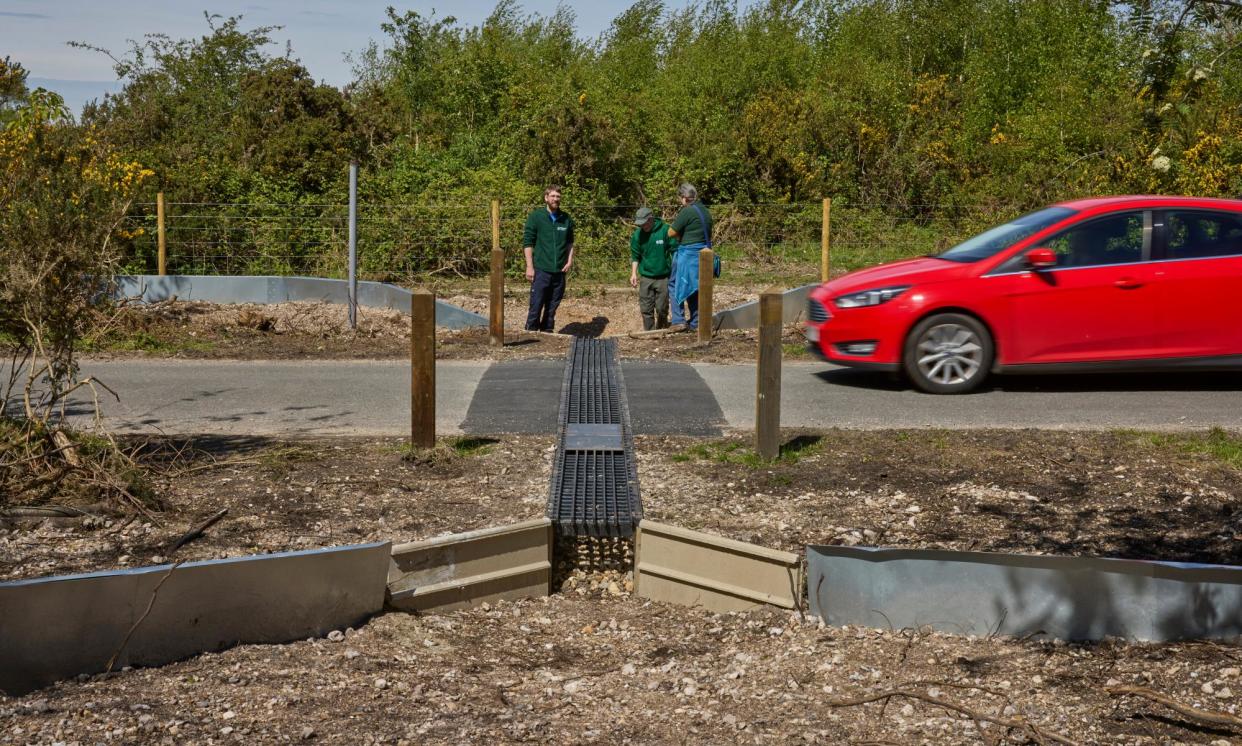Adder girl! Tunnels aim to encourage British snakes to mix and breed

How did the adder cross the road? It didn’t – it was too scared.
Now, however, road-shy populations of the increasingly endangered snake are being given a helping hand with the construction of Britain’s first adder tunnels.
The two tunnels, which run beneath a road bisecting Greenham and Crookham Commons in Berkshire, have been designed to appeal to the heat-seeking reptiles.
Britain’s only venomous snake has vanished from central England over the last decade because of persecution, habitat fragmentation and the growth of pheasant shoots, with non-native pheasants predating the small vipers.
“We’ve got a biodiversity crisis. We need to be doing new and innovative things,” said Tom Hayward, of the Berks, Bucks and Oxon Wildlife Trust (BBOWT). “We need to be thinking outside the box as to how we benefit these species.”
The snake has has not been seen in Buckinghamshire since 2014 and is now virtually extinct in Oxfordshire. Greenham Common, which became a nature reserve 24 years ago after the closure of the RAF nuclear weapons base, is one of its last strongholds in the region.
The tunnels opened for snakes this spring after radio-tagging studies showed two adder populations on the commons were not mixing because of the road. The populations need to meet each other to breed and boost their genetic diversity.
Debbie Lewis, the head of ecology for BBOWT, said: “The aim is to enable them to mix and become more resilient in the future. At the moment they are isolated populations and genetics is very important in their survival.
“It’s a species that’s hanging by a thread and it would be tragic if it disappeared.”
The roads are an obstacle because adders avoid open ground, where they are vulnerable to predation from birds. If an often slow-moving adder does cross a road it is likely to be hit by a car.
BBOWT’s tunnels project, funded with £113,000 from Natural England’s species recovery programme, has created winding corridors of adder-friendly brash (cut branches) through the commons, with 100 metres of low, solid sheet-metal fencing to funnel the snakes to each tunnel entrance.
Once inside the concrete-type resin tunnel, the snakes encounter a thick floor of large pebbles which they can grip on to and which are warmed by the sun shining through a metal grill roofto create an appealing temperature.
“We could’ve put heating in but then the danger is the snakes would’ve never left the tunnels,” Hayward said.
Similar tunnels have been built in the Netherlands and Canada, where a variety of reptiles and amphibians have been filmed using them.
Adders are vanishing because they are persecuted by people who are afraid of the snake or do not want their pet dogs to be bitten, and by enthusiasts seeking photographs who lift up tin sheets put down to provide warm homes for the adders.
Adders can live for up to 30 years but females do not breed every year, rarely move, and are particularly vulnerable to disturbance.
The fragmentation of habitats has also reduced numbers but conservationists are concerned about the impact of non-native pheasants, of which more than 31 million are released into the countryside each year.
Lewis said: “The problem is we’ve filled our country with pheasants and in spring, when adders are moving around, wildlife organisations cannot control [shoot] pheasants because there is a close-season. Pheasants have an instinct to peck adders’ eyes out to protect their young.”
Camera traps will be fitted inside the tunnels, which are unlikely to be used immediately by the snakes because there is not yet enough plant cover on the areas leading to them. Adders will be radio-tagged and monitored for three years as part of the project.
Roger Stace, the West Berkshire land manager for BBOWT, said: “It would be really nice if this could be a showcase and we get other land managers interested in what we’ve done, replicating it and improving it.”


